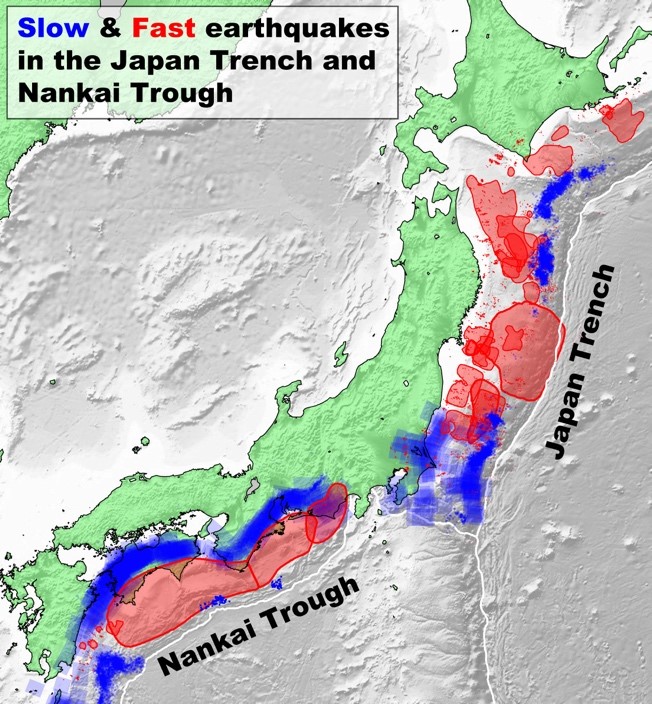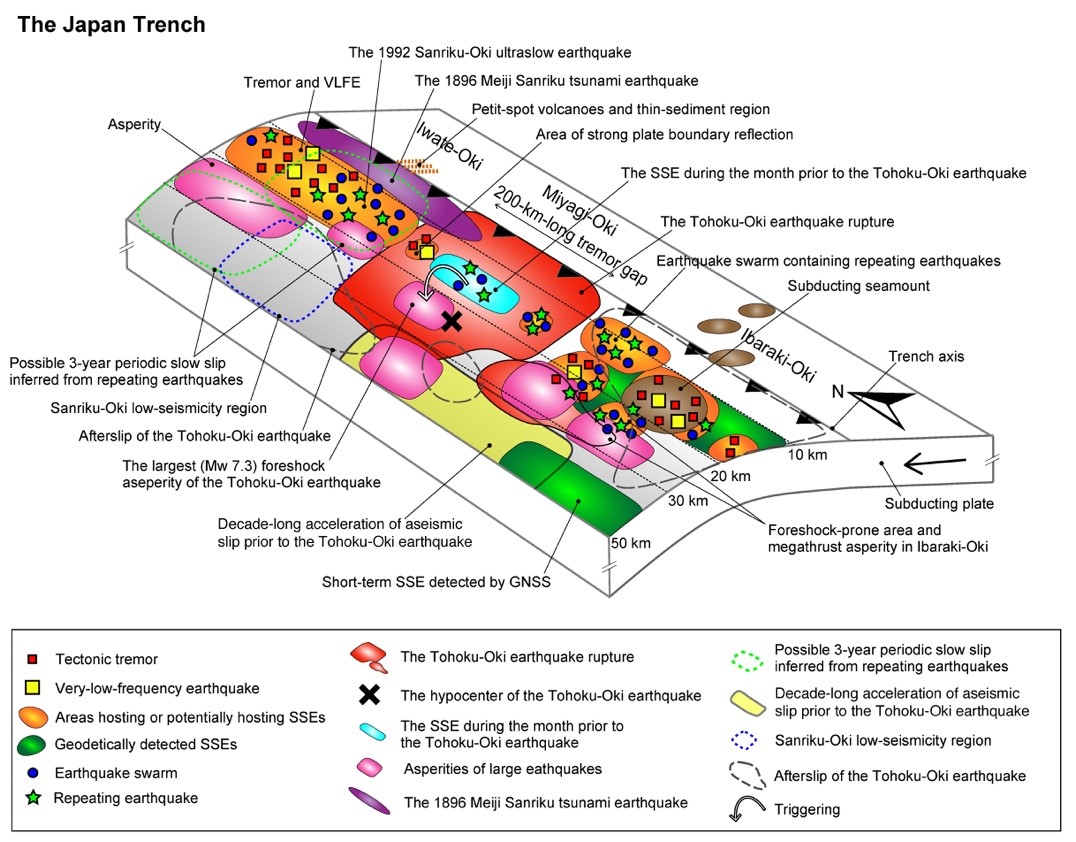Essay on: "Review on slow earthquakes in the Japan Trench"
- Essay author: Tomoaki Nishikawa
- Article authors: Tomoaki Nishikawa1, Satoshi Ide2 and Takuya Nishimura1
- 1DPRI, Kyoto University
- 2The University of Tokyo
Slow earthquakes are episodic slow fault slips. They form a fundamental component of interplate deformation processes, along with fast, regular earthquakes (Ide et al., 2007). Recent seismological and geodetic observations (e.g., Nishikawa et al., 2019) have revealed detailed slow earthquake activity along the Japan Trench—the subduction zone where the March 11, 2011, moment magnitude 9.0 Tohoku-Oki earthquake occurred. Based on the recent research advance, we presented the first review on slow earthquake research in the Japan Trench and its history (Nishikawa et al., 2023).
By compiling the observations of slow earthquakes (e.g., tectonic tremors, very-low-frequency earthquakes, and slow slip events) and related fault slip phenomena (e.g., small repeating earthquakes, earthquake swarms, and foreshocks of large interplate earthquakes), we drew an integrated slow earthquake map along the Japan Trench (Figure 1). We found that slow and megathrust earthquakes are spatially complementary in distribution, and that slow earthquakes sometimes trigger fast earthquakes in their vicinities. An approximately 200-km-long along-strike gap of seismic slow earthquakes (i.e., tectonic tremors and very-low-frequency earthquakes) (Figure 1) corresponds with the huge interplate locked zone of the central Japan Trench (e.g., Nishimura et al., 2004). The Tohoku-Oki earthquake ruptured this locked zone, but the rupture terminated without propagating deep into the slow-earthquake-genic regions in the northern and southern Japan Trench. Given the above observation and the fact that slow earthquakes were observed during the month preceding the Tohoku-Oki earthquake near its rupture initiation point, slow earthquakes were probably involved in both the rupture initiation and termination processes of the Tohoku-Oki earthquake.

Figure 1. Distribution of slow and fast earthquakes in the Japan Trench and Nankai Trough. Blue and red symbols indicate slow and fast earthquakes, respectively
We then compared the integrated slow earthquake distribution with seismicity parameters (Gutenberg–Richter relationship’s b-value, the tidal response of seismicity, and the p-value of Omori–Utsu’s aftershock law), the crustal structure (e.g., interplate sedimentary units, subducting seamounts, petit-spot volcanoes, horst and graben structures, residual gravity, seismic velocity structure, and plate boundary reflection intensity), and the geological environment (e.g., water sources, pressure–temperature conditions, and metamorphism). The results show that Omori–Utsu’s p-value (Ogata, 2011) is particularly high (approximately 1.4) near the slow-earthquake-genic regions in the shallow part of the Japan Trench. This implies that aftershock activity rapidly decays in time around the regions. Furthermore, the shallow slow-earthquake-genic regions are found to be located near fluid-rich sedimentary units (Tsuru et al., 2002), subducting seamounts that entrain sediments (Mochizuki et al., 2008), interplate areas of strong seismic reflection intensity (e.g., Fujie et al., 2001), and the depth at which minerals in sediments (opal and smectite) dehydrate (Hyndman & Peacock, 2003), implying that the distribution of water at the plate boundary corresponds to the distribution of slow earthquakes.
Finally, we discussed the use of slow earthquake observations for forecasting fast earthquake activity. In the Japan Trench, slow earthquakes triggering large earthquakes and swarms of small-to-moderate earthquakes have been reported (e.g., Uchida et al., 2016). Slow earthquakes accompanied by a swarm of foreshocks were also observed just before the Tohoku-Oki earthquake (e.g., Ito et al., 2013). In light of these observations, slow earthquake observations are expected to be useful in forecasting interplate seismicity. For example, real-time monitoring of slow earthquake activity and accompanying earthquake swarms may enable us to detect foreshock activity of impending large earthquakes. Furthermore, incorporating the seismicity-triggering effects of slow earthquakes into statistical (Ogata, 1988; Zhuang et al., 2002) and physical (Dieterich, 1994) seismicity models could improve the forecasts of fast earthquakes. It is also important for short-term forecasts of large earthquakes to clarify the presence/absence of features specific to slow earthquakes that precede megathrust earthquakes.
The Japan Trench has a surprisingly complex distribution of slow and fast earthquakes, and these earthquakes interact (Figure 2). Further investigation of the factors that govern this complex distribution and the interaction between the two types of earthquakes is expected to provide important insights into the physics of slow earthquakes and improve forecasts of fast earthquakes.

Figure 2. Schematic of the megathrust slip behavior of the Japan Trench.
Reference
- Dieterich J (1994) A constitutive law for rate of earthquake production and its application to earthquake clustering. J Geophys Res 99(B2):2601–2618. https://doi.org/10.1029/93JB02581
- Fujie G, Kasahara J, Hino R, Sato T, Shinohara M, Suyehiro K (2002) A significant relation between seismic activities and reflection intensities in the Japan Trench region. Geophys Res Lett 29(7):1100. https://doi.org/10.1029/2001GL013764
- Hyndman RD, Peacock SM (2003) Serpentinization of the forearc mantle. Earth Planet Sci Lett 212(3–4):417–432. https://doi.org/10.1016/S0012-821X(03)00263-2
- Ide S, Beroza GC, Shelly DR, Uchide T (2007) A scaling law for slow earthquakes. Nature 447(7140):76–79. https://doi.org/10.1038/nature05780
- Ito Y, Hino R, Kido M, Fujimoto H, Osada Y, Inazu D, Ohta Y, Iinuma T, Ohzono M, Miura S, Mishima M, Suzuki K, Tsuji T, Ashi J (2013) Episodic slow slip events in the Japan subduction zone before the 2011 Tohoku-Oki earthquake. Tectonophysics 600:14–26. https://doi.org/10.1016/j.tecto.2012.08.022
- Mochizuki K, Yamada T, Shinohara M, Yamanaka Y, Kanazawa T (2008) Weak interplate coupling by seamounts and repeating M ~ 7 earthquakes. Science 321(5893):1194–1197. https://doi.org/10.1126/science.1160250
- Nishikawa T, Matsuzawa T, Ohta K, Uchida N, Nishimura T, Ide S (2019) The slow earthquake spectrum in the Japan Trench illuminated by the S-net seafloor observatories. Science 365(6455):808–813. https://doi.org/10.1126/science.aax5618
- Nishikawa T, Ide S, Nishimura T (2023) A review on slow earthquakes in the Japan Trench. Prog Earth Planet Sci 10:1. https://doi.org/10.1186/s40645-022-00528-w
- Nishimura T, Hirasawa T, Miyazaki SI, Sagiya T, Tada T, Miura S, Tanaka K (2004) Temporal change of interplate coupling in northeastern Japan during 1995–2002 estimated from continuous GPS observations. Geophys J Int 157(2):901–916. https://doi.org/10.1111/j.1365-246X.2004.02159.x
- Ogata Y (1988) Statistical models for earthquake occurrences and residual analysis for point processes. J Am Stat Assoc 83(401):9–27
- Ogata Y (2011) Significant improvements of the space-time ETAS model for forecasting of accurate baseline seismicity. Earth Planet Space 63(3):217–229. https://doi.org/10.5047/eps.2010.09.001
- Tsuru T, Park JO, Miura S, Kodaira S, Kido Y, Hayashi T (2002) Along-arc structural variation of the plate boundary at the Japan Trench margin: Implication of interplate coupling. J Geophys Res 107(B12):2357. https://doi.org/10.1029/2001JB001664
- Uchida N, Iinuma T, Nadeau RM, Bürgmann R, Hino R (2016) Periodic slow slip triggers megathrust zone earthquakes in northeastern Japan. Science 351(6272):488–492. https://doi.org/10.1126/science.aad3108
- Zhuang J, Ogata Y, Vere-Jones D (2002) Stochastic declustering of space-time earthquake occurrences. J Am Stat Assoc 97(458):369–380. https://doi.org/10.1198/016214502760046925